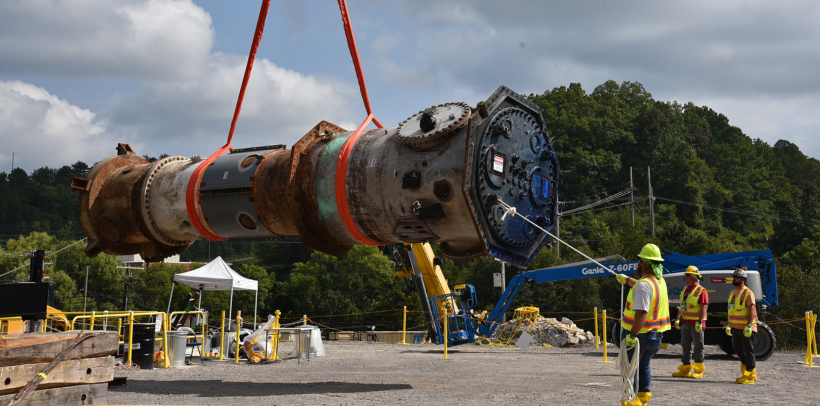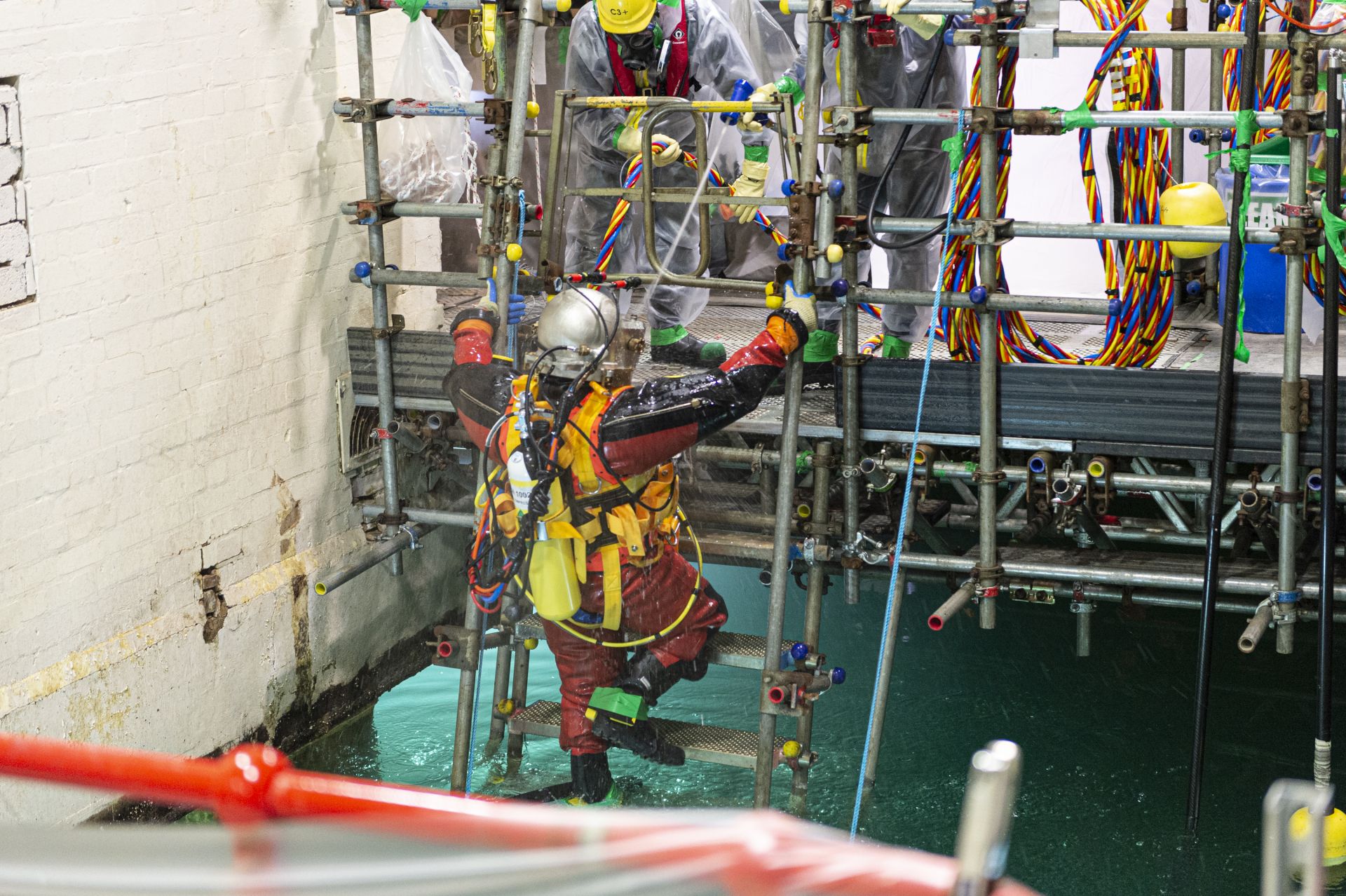Contaminated soil is loaded in containers for disposal at the Oak Ridge Reservation in Tennessee. (Photo: DOE)
The Department of Energy’s Office of Environmental Management said a new regulatory partnership framework established in recent years by the Oak Ridge Office of Environmental Management (OREM), its contractor United Cleanup Oak Ridge (UCOR), the Environmental Protection Agency, and the Tennessee Department of Environment and Conservation (TDEC) is ushering in a new chapter of accelerated cleanup at the department’s Oak Ridge Reservation in Tennessee.
Ray Tran, an engineer for Savannah River tank farms, helps complete a timeline of SRS historical events as part of SRMC’s vision casting training initiative. (Photo: DOE)
More than 3,000 employees with Department of Energy contractor Savannah River Mission Completion (SRMC) participated in a vision casting initiative, learning more about the past, present, and future of the Savannah River Site’s liquid waste mission.
The Low Intensity Test Reactor structure is lifted from its housing and placed in a specialized carbon metal container for shipment for disposal. (Photo: DOE)
The Department of Energy’s Office of Environmental Management announced it has completed a second of its 2023 priorities at Oak Ridge in as many months with the demolition of the Low Intensity Test Reactor, known as Building 3005, at the Tennessee site.
Watch a video of Building 3005 and its decommissioning here.
Workers remove contaminated sediment from the SRS in South Carolina. A $19 million DOE grant will support state monitoring of the site. (Photo: DOE)
The Department of Energy’s Office of Environmental Management has awarded nearly $54 million in noncompetitive financial assistance grants and cooperative agreements to help support the office’s cleanup program. DOE-EM is responsible for environmental legacy cleanup of the effects of decades of nuclear weapons development and government-sponsored nuclear energy research.
Josh Everett, a diver with UCC UK Ltd., enters bay No. 11 of Sellafield’s Pile Fuel Storage Pond in December 2022, the first time in over 60 years a diver has entered the legacy pond, used to store a variety of spent nuclear fuel types and wastes. During this commissioning nuclear dive, Everett’s underwater tasks included emergency diver extraction trial confirmation, radiation monitoring system verification, and radiation contact meter commissioning. (Photos courtesy of Sellafield Ltd.)
The last time a human entered the Pile Fuel Storage Pond at the Sellafield nuclear site in Cumbria, England, was in 1958, when records show a maintenance operator and health physics monitor carried out a dive into the newly constructed pond to repair a broken winch. At least that was true until December 2022, when Josh Everett, a diver from the U.K. specialist nuclear diving team Underwater Construction Corporation (UCC) UK Ltd., became the first person in more than 60 years to work in one of the most unique workplaces in the world.
The Atlas railcar carries a test load simulating a shipment of spent nuclear fuel. (Photo: DOE)
The Department of Energy’s Office of Nuclear Energy has wrapped up testing of its Atlas railcar, successfully completing a round-trip journey from Pueblo, Colo., to Scoville, Idaho. Built to safety standards set by the Association of American Railroads (AAR), the 12-axle railcar is designed to transport large containers of spent nuclear fuel and high-level radioactive waste.
A Department of Ecology inspector at the Hanford Site. (Photo: Department of Ecology)
Washington state’s Department of Ecology said it has reached a settlement with the Department of Energy over access to data the state described as “critical” to the cleanup of the Hanford Site near Richland, Wash.
A startup heater is removed from a melter in the Vit Plant’s Low-Activity Waste Facility. (Photo: DOE)
Workers at the Hanford Site’s Waste Treatment and Immobilization Plant, also known as the Vit Plant, have begun removing the first three of 18 temporary startup heaters, the Department of Energy announced on September 12. The startup heaters were used to raise the first of two 300-ton glass melters in the plant’s Low-Activity Waste Facility to its operating temperature of 2,100°F.
A West Valley ancillary support building is demolished in 2018. (Photo: DOE/CH2M Hill–BWXT West Valley)
The Department of Energy’s Office of Environmental Management has issued a draft request for proposal for a contract covering the next phase of cleanup at the West Valley Demonstration Project in western New York.
DOE-EM senior advisor Ike White provided remarks to the audience during 7th International Forum on the Decommissioning of the Fukushima Daiichi Nuclear Power Station. (Photo: DOE)
Senior advisor Ike White and others with the Department of Energy’s Office of Environmental Management traveled to Japan this week to attend the 7th International Forum on the Decommissioning of the Fukushima Daiichi Nuclear Power Station.
An elk herd at the DOE’s Hanford Site in Washington state. (Photo: DOE)
The Department of Energy has released the first request for information (RFI) related to the department’s Cleanup to Clean Energy initiative, which aims to repurpose certain DOE-owned lands, portions of which were previously used in the nation’s nuclear weapons program, into sites for clean energy generation.
Monticello nuclear power plant. (Photo: Xcel Energy)
The Minnesota Public Utilities Commission (PUC) has approved Xcel Energy’s request for a certificate of need to expand spent fuel storage at the utility’s Monticello nuclear power plant.
The additional storage, according to the PUC, requires installation of a second concrete support pad and modular concrete storage system designed to hold 14 additional steel canisters.
Xcel had requested increased outdoor storage to accommodate its plan to extend Monticello’s operational life by 10 years, to 2040.
Work crews remove old infrastructure near the Hanford Site’s Cold War–era PUREX plant. (Photo: DOE)
Demolition is underway on several former chemical storage tanks and associated infrastructure near the Plutonium Uranium Extraction (PUREX) plant, the final and most advanced chemical separations facility at the Department of Energy’s Hanford Site.
The project is expected to be completed by the end of September.


















